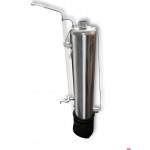
All About the Operating Modes of Household Autoclaves
Thermal sterilization of food has become accessible at home—one just needs to purchase a quality household autoclave and strictly follow the operating instructions. Properly conducted autoclave heat treatment ensures:
- Destruction of microorganisms.
- Reduction of the number of microorganism spores to a level that allows for long-term storage of preserves at average room temperature.
The second point contains the main difference between sterilization and pasteurization—bringing to a boil for the purpose of destroying microorganisms. Most of them die before reaching 100 degrees Celsius; however, spores remain. If a pasteurized product is placed in the refrigerator, they "sleep," but if stored in a regular pantry, they may begin to multiply. To ensure that preserves can be stored safely at normal temperatures, a household autoclave is needed.
.jpg)
Let’s consider the main operating modes of the device, which depend on what needs to be sterilized.
The sterilization process in the autoclave occurs under high pressure. When the unit is filled with water and it begins to boil, the steam rises to the very top, ensuring reliable preservation throughout the entire height.
General Principles to Follow
- Compare the temperature specified in your chosen recipe with the temperature table of your household autoclave. Prefer the manufacturer’s recommendations over those found on internet forums.
- Do not reuse a lid multiple times, even if it is claimed to be reusable. Upon opening, the rubber seal or threading gets deformed, creating micro-cracks—it's not worth risking your health or ruining your preserves just to save 5-10 hryvnias.
- Both temperature and time of exposure are important. The main goal is not only to achieve product sterility but also to maintain its taste, nutritional value, and benefits. Deep denaturation of tissues due to excessive heating or significant increases in processing time at reduced temperatures must be avoided. In the first case, flavor will deteriorate; in the second, spores will remain. The optimal option is to heat to the highest possible temperature for the product in the shortest possible time.
Choosing the correct operating mode of the autoclave is essential, taking into account the special properties of the canned product.
Sterilization of Meat Preserves
The acceptable heating level for any meat is 120 degrees. This applies to beef, lamb, chicken, rabbit, pork, and fish. Exceeding this value can destroy proteins, resulting in an unpalatable and less nutritious dish. This temperature is commonly used in the production of industrial preserves. Such industrial sterilizers for jars can be purchased from us.
The sterilization time for meat preserves depends on the volume of the jar: the larger the container, the longer it must remain in the autoclave. Since meat is dense, it should not be packed in jars larger than 1 liter; otherwise, the degree of processing will vary between the center and the edges.
A half-liter jar can be processed in 40 minutes, while a liter jar takes 50 minutes. Chicken and fish, as well as meat from young lambs or piglets, are more delicate; you can reduce the high-temperature exposure time by 10-15 minutes. Conversely, if the preserves are made from an older animal or game, add an additional 15 minutes.
Vegetable and Fruit Preserves
Many home canning enthusiasts believe that "sterilizing" in a pot of boiling water is sufficient, especially when they learn that the same 100 degrees is used in an autoclave for vegetables. However, the advantage of a household sterilizer is obvious: it can accommodate jars that are already sealed!
This eliminates the risk of recontamination after removing the heat source and conducting sealing manipulations, unlike situations with pots, kettles, stoves, and other home tricks. For any size of jars, 15-20 minutes of processing is sufficient, as the marinade or syrup is liquid and the density of vegetables and fruits is low. Larger jars of 2-3 liters can also be used.
Mushroom Preserves: Be Careful!
Selecting the right operating mode of a household autoclave for sterilizing mushrooms is of utmost importance, and here’s why:
- Mushrooms should not be heated to 120 degrees Celsius—their delicate protein structure begins to break down. Only short exposure to 110 degrees is acceptable!
- If you decide to be lenient with mushrooms and reduce the temperature or time too much, you risk serious poisoning!
Therefore, follow these principles:
- Pre-marinate mushrooms in an acidic environment (vinegar, lemon, etc.).
- Use half-liter, or at most, liter containers.
- Follow the sterilization time established by the manufacturer. Typically, it is 30 minutes for 0.5 liters and 40 minutes for 1 liter.
Caring for the health of loved ones, hard work, and a love for all things natural and beneficial distinguish those who engage in home preservation amidst the frantic pace of modern life. Well-made preserves, crafted with care and according to all the rules, are beneficial and profitable! Don’t skimp on your health or waste time on old sterilization methods—purchase a household autoclave and be confident in the quality of your preserves!
We hope our tips have helped you. All the best!
Read also:
- Autoclave Operating Modes
- What is an Autoclave
- Hydraulic Testing of Autoclaves
- How to Use an Autoclave
- How to Choose an Autoclave









